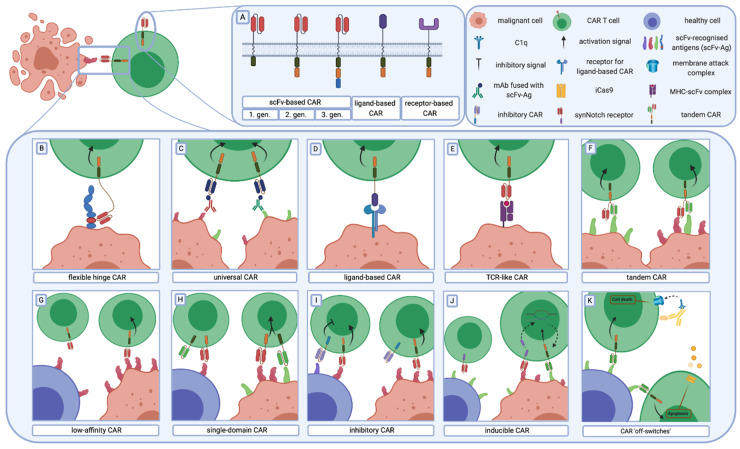Figure 1.
The CAR structure and general strategies to enhance CAR-T cell therapy. (A) Three generations of chimeric antigen receptors are based on the composition of the intracellular part. First-generation CARs contain one stimulation domain, whereas second and third generations have one or two additional costimulatory domains, respectively. Besides scFv, other molecules (ligands or receptors) are used as antigen recognition domains. (B–F) Strategies to increase CAR-T cell efficacy and selectivity against tumour cells. (B) Epitopes, located adjacent to the cell membrane, require a longer and more flexible hinge than those easily accessible for CARs. (C) In universal CARs, by targeting an epitope fused with an antibody, specificity relies mostly on antibody selectivity. (D) The use of a ligand instead of scFv as an antigen recognition domain could increase the specificity of CAR-T cells. (E) TCR-like CAR-T cells target intracellular cancer-specific antigens that are presented by MHC. (F) Tandem CARs are designed to target more than one antigen simultaneously. They recognise two different antigens and provide effective lysis of malignant cells expressing one or both cognate antigens. (G–K) Strategies to decrease on-target off-tumour toxicity and the probability of healthy cells lysis. (G) Decreased affinity toward cognate antigen enables CAR-T cells to distinguish healthy cells with a low expression level of TAAs from malignant cells with a high level of TAAs. (H) The division of the full activation signal to two independent CARs with different antigen specificities restrict the CAR-T cell’s cytotoxicity to malignant cells that express both targeted antigens while sparing healthy cells with only one antigen on their surface. (I) Additional co-modification of CAR-T cells with iCAR enables specific recognition of non-malignant cells and inhibition of toxicity against them. (J) The expression of the “effector” CAR is regulated by the synNotch receptor redirected against another TAA. (K) CAR “off-switches” are based on the co-modification of CAR-T cells with antibody-recognised molecules or with iCas9. This enables selective CAR-T cell clearance while CAR-related life-threatening side effects occur. Abbreviations: CAR—chimeric antigen receptor, scFv—single-chain variable fragment, mAb—monoclonal antibody, Ag—antigen, iCas9—inducible caspase 9, TCR—T-cell receptor, MHC—major histocompatibility complex, TAA—tumour-associated antigen, iCAR—inhibitory CAR, synNotch receptor—synthetic Notch receptor.

